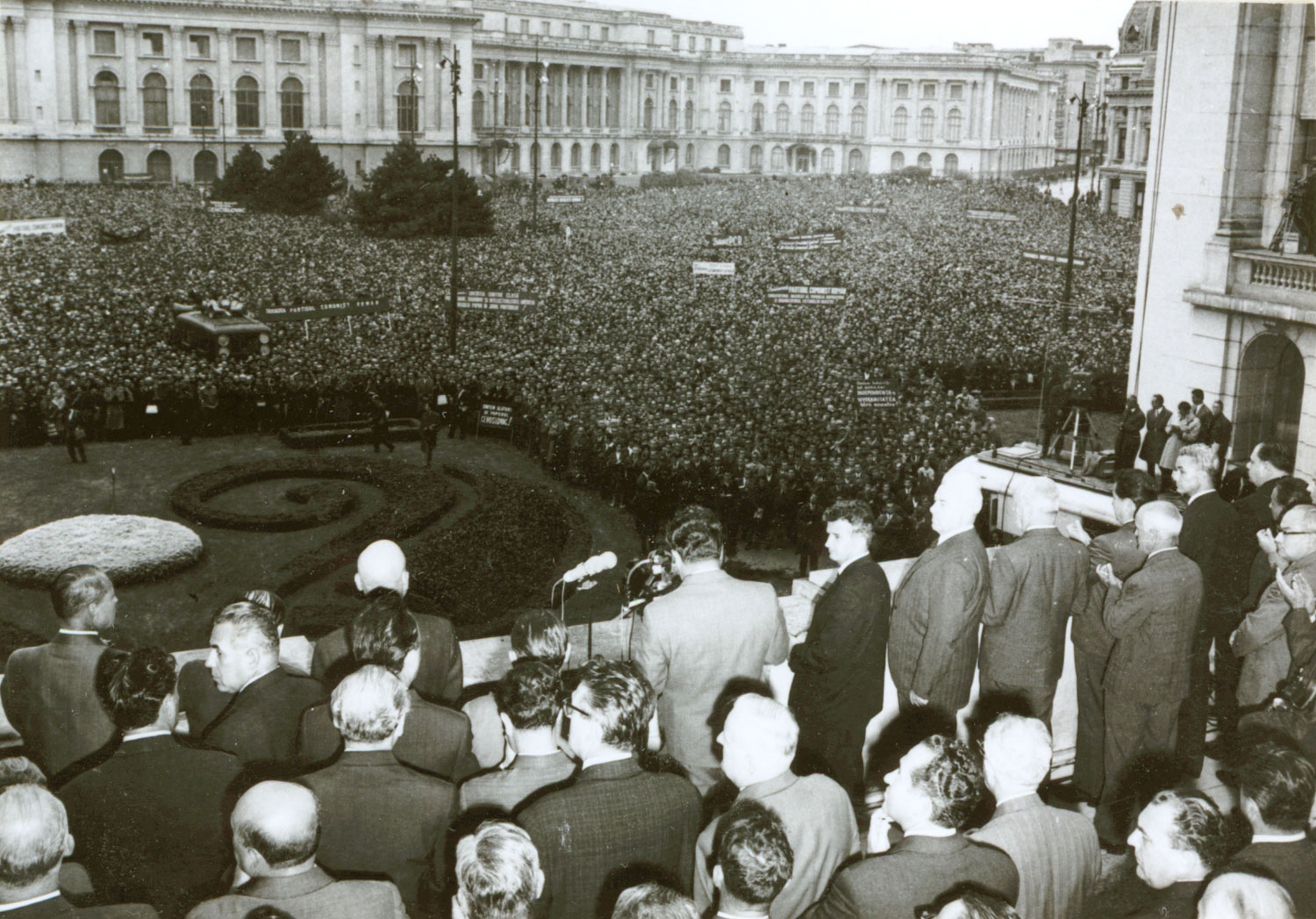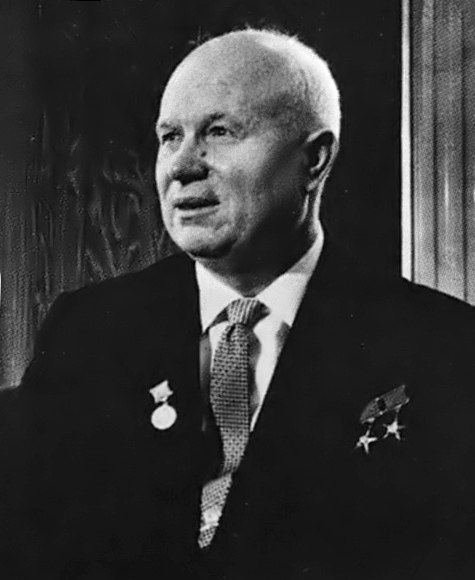|
Ceaușescu's Speech Of 21 August 1968
Ceaușescu's speech of 21 August 1968 was a public address by Nicolae Ceaușescu, General Secretary of the Romanian Communist Party and President of the State Council of Romania, strongly condemning the Warsaw Pact invasion of Czechoslovakia. On the night of 20–21 August 1968, five Warsaw Pact nations (the Soviet Union, Bulgaria, Hungary, East Germany, and Poland) invaded Czechoslovakia in an effort to quell the reformist ideology of Alexander Dubček, the First Secretary of the Communist Party of Czechoslovakia. On 21 August, in what became one of his most famous speeches, Ceaușescu boldly denounced the invasion in a public address before 100,000 people in Palace Square in Bucharest, and he declared that it was a "grave error and constituted a serious danger to peace in Europe and for the prospects of world socialism". His address was perceived as a bold gesture of disobedience to the Soviet Union both at home and abroad. The speech was part of the Romanian go ... [...More Info...] [...Related Items...] OR: [Wikipedia] [Google] [Baidu] |
Socialism With A Human Face
Socialism with a human face ( cs, socialismus s lidskou tváří, sk, socializmus s ľudskou tvárou) is a slogan referring to the reformist and democratic socialist programme of Alexander Dubček and his colleagues, agreed at the Presidium of the Communist Party of Czechoslovakia in April 1968, after he became chairman of the KSČ in January 1968. The first author of this slogan was Radovan Richta, and it was a process of moderate democratization, economic modernization, and political liberalization that sought to build an advanced and modern socialist society that valued democratic Czechoslovakian tradition while still allowing the Communist Party to continue governing. Socialism with a human face was vital in initiating the Prague Spring, a period of national democratization and economic decentralization. It was, however, rolled back by the Warsaw Pact invasion of Czechoslovakia on August 21, 1968. Background The programme was an attempt to overcome the disillusio ... [...More Info...] [...Related Items...] OR: [Wikipedia] [Google] [Baidu] |
1968 In Romania
The year was highlighted by protests and other unrests that occurred worldwide. Events January–February * January 5 – "Prague Spring": Alexander Dubček is chosen as leader of the Communist Party of Czechoslovakia. * January 10 – John Gorton is sworn in as 19th Prime Minister of Australia, taking over from John McEwen after being elected leader of the Liberal Party the previous day, following the disappearance of Harold Holt. Gorton becomes the only Senator to become Prime Minister, though he immediately transfers to the House of Representatives through the 1968 Higgins by-election in Holt's vacant seat. * January 15 – The 1968 Belice earthquake in Sicily kills 380 and injures around 1,000. * January 21 ** Vietnam War: Battle of Khe Sanh – One of the most publicized and controversial battles of the war begins, ending on April 8. ** 1968 Thule Air Base B-52 crash: A U.S. B-52 Stratofortress crashes in Greenland, discharging 4 nuclear bombs. * Janua ... [...More Info...] [...Related Items...] OR: [Wikipedia] [Google] [Baidu] |
Censorship In Romania
Censorship in Communist Romania occurred during the Socialist Republic in two stages: under the first Communist president Gheorghe Gheorghiu-Dej (1947-1965) and the second and last Communist president Nicolae Ceaușescu (1965-1989). Before the World War ΙΙ period The Romanian Communist Party (PCR) was not even popular back then, and thus, the Romanian society was not highly censored under the democracy before World War II. Up until the start of the war, Romania had a tendency to become closer to Western European countries; it tried to establish a free market economy, people had access to an abundance of books from all over the world, one could freely travel, there was a thorough education system, and a literature of her own. Romania had its own social infrastructure and people had freedom to some degree. When it comes to the Romanian Communist Party, it had no way to gain popular support in the context of the Soviet Union being seen as a hostile neighbor until the end of ... [...More Info...] [...Related Items...] OR: [Wikipedia] [Google] [Baidu] |
Socialist Realism
Socialist realism is a style of idealized realistic art that was developed in the Soviet Union and was the official style in that country between 1932 and 1988, as well as in other socialist countries after World War II. Socialist realism is characterized by the depiction of communist values, such as the emancipation of the proletariat. Despite its name, the figures in the style are very often highly idealized, especially in sculpture, where it often leans heavily on the conventions of classical sculpture. Although related, it should not be confused with social realism, a type of art that realistically depicts subjects of social concern, or other forms of "realism" in the visual arts. Socialist realism was made with an extremely literal and obvious meaning, usually showing an idealized USSR. Socialist realism was usually devoid of complex artistic meaning or interpretation. Socialist realism was the predominant form of approved art in the Soviet Union from its development in ... [...More Info...] [...Related Items...] OR: [Wikipedia] [Google] [Baidu] |
Speeches By Heads Of State
This list of speeches includes those that have gained notability in English or in English translation. The earliest listings may be approximate dates. Before the 1st century *c.570 BC : Gautama Buddha gives his first sermon at Sarnath *431 BC: Funeral Oration by the Greek statesman Pericles, significant because it departed from the typical formula of Athenian funeral speeches and was a glorification of Athens' achievements, designed to stir the spirits of a nation at war. *399 BC: The Apology of Socrates, Plato's version of the speech given by the philosopher Socrates, defending himself against charges of being a man "who corrupted the young, refused to worship the gods, and created new deities." *330 BC: On the Crown by the Greek orator Demosthenes, which illustrated the last great phase of political life in Athens. *63 BC: Catiline Orations, given by Marcus Tullius Cicero, the consul of Rome, exposing to the Roman Senate the plot of Lucius Sergius Catilina and his friend ... [...More Info...] [...Related Items...] OR: [Wikipedia] [Google] [Baidu] |
We Will Bury You
"We will bury you" (russian: «Мы вас похороним!», translit="My vas pokhoronim!") is a phrase that was used by Soviet First Secretary Nikita Khrushchev while addressing Western ambassadors at a reception at the Polish embassy in Moscow on November 18, 1956. The phrase was originally translated into English by Khrushchev's personal interpreter Viktor Sukhodrev. The phrase was received very negatively by contemporary Western audiences, but modern translators have suggested the phrase was mistranslated or taken out of context. History While addressing the Western Bloc at the embassy on November 18, 1956, in the presence of communist Polish statesman Władysław Gomułka, First Secretary Khrushchev said: "About the capitalist states, it doesn't depend on you whether or not we exist. If you don't like us, don't accept our invitations, and don't invite us to come to see you. Whether you like it or not, history is on our side. We will bury you!" The speech prompted th ... [...More Info...] [...Related Items...] OR: [Wikipedia] [Google] [Baidu] |
Patriotic Guards (Romania)
The Patriotic Guards ( ro, Gărzile Patriotice) were Romanian paramilitary formations formed during the Communist era, designed to provide additional defence in case of a foreign attack. History The Patriotic Guards were formed in 1968, after the 21 August Bucharest speech through which Romanian Communist Party General Secretary and State Council President Nicolae Ceaușescu condemned the suppression of the Prague Spring by Soviet and Warsaw Pact forces. Ceaușescu appealed to anti-Sovietism within the general population to ask for resistance against the perceived threat of a similar Soviet invasion against Romania itself. The nationalist themes he used had their immediate effect in rallying large portions of the public, who began organizing and arming themselves under the direction of the Romanian Communist Party (PCR). Although the threat was over by the end of the year, the Patriotic Guards remained a feature of the republic's communist structure. They became a pe ... [...More Info...] [...Related Items...] OR: [Wikipedia] [Google] [Baidu] |
Moscow
Moscow ( , US chiefly ; rus, links=no, Москва, r=Moskva, p=mɐskˈva, a=Москва.ogg) is the capital and largest city of Russia. The city stands on the Moskva River in Central Russia, with a population estimated at 13.0 million residents within the city limits, over 17 million residents in the urban area, and over 21.5 million residents in the metropolitan area. The city covers an area of , while the urban area covers , and the metropolitan area covers over . Moscow is among the world's largest cities; being the most populous city entirely in Europe, the largest urban and metropolitan area in Europe, and the largest city by land area on the European continent. First documented in 1147, Moscow grew to become a prosperous and powerful city that served as the capital of the Grand Duchy that bears its name. When the Grand Duchy of Moscow evolved into the Tsardom of Russia, Moscow remained the political and economic center for most of the Tsardom's history. When ... [...More Info...] [...Related Items...] OR: [Wikipedia] [Google] [Baidu] |
Bucharest
Bucharest ( , ; ro, București ) is the capital and largest city of Romania, as well as its cultural, industrial, and financial centre. It is located in the southeast of the country, on the banks of the Dâmbovița River, less than north of the Danube River and the Bulgarian border. Bucharest was first mentioned in documents in 1459. The city became the capital of Romania in 1862 and is the centre of Romanian media, culture, and art. Its architecture is a mix of historical (mostly Eclectic, but also Neoclassical and Art Nouveau), interbellum ( Bauhaus, Art Deco and Romanian Revival architecture), socialist era, and modern. In the period between the two World Wars, the city's elegant architecture and the sophistication of its elite earned Bucharest the nickname of 'Paris of the East' ( ro, Parisul Estului) or 'Little Paris' ( ro, Micul Paris). Although buildings and districts in the historic city centre were heavily damaged or destroyed by war, earthquakes, and even Ni ... [...More Info...] [...Related Items...] OR: [Wikipedia] [Google] [Baidu] |
Revolution Square, Bucharest
Revolution Square ( ro, Piața Revoluției) is a square in central Bucharest, on Calea Victoriei. Known as Palace Square (Romanian: ''Piața Palatului'') until 1989, it was renamed after the Romanian Revolution The Romanian Revolution ( ro, Revoluția Română), also known as the Christmas Revolution ( ro, Revoluția de Crăciun), was a period of violent civil unrest in Romania during December 1989 as a part of the Revolutions of 1989 that occurred ... of Revolutions of 1989, December 1989. The former Romanian Royal Family, Royal Palace (now the National Museum of Art of Romania), the Romanian Athenaeum, Athenaeum, the Athénée Palace Hotel, the University of Bucharest Library and the Memorial of Rebirth are located here. The square also houses the building of the former Central Committee of the Romanian Communist Party (from where Nicolae Ceaușescu and his wife fled by helicopter on December 22, 1989). In 1990, the building became the seat of the Senate of Romania, Senate ... [...More Info...] [...Related Items...] OR: [Wikipedia] [Google] [Baidu] |





